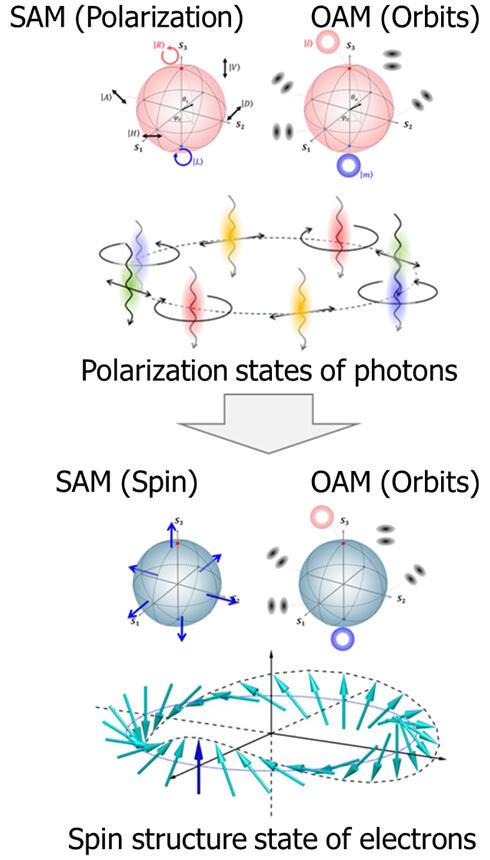A research team comprising Professor Ken Morita, Professor Katsuhiko Miyamoto, and Professor Takashige Omatsu of the Graduate School of Engineering at Chiba University, Researcher Satoshi Iba of the National Institute of Advanced Industrial Science and Technology, Assistant Professor Jun Ishihara of Tohoku University, and Associate Professor Nobuhiko Yokoshi of Osaka Metropolitan University succeeded in transferring the quantum mechanical information of photons, which have a spatial polarization structure, to the spatial spin structure of electrons in a semiconductor. Photons with a spatial polarization structure are high-order photons that carry quantum information regarding the spin and orbital angular momentums and in principle, can transmit an infinite amount of information per photon. The results of this study will lead to the realization of high-dimensional quantum interfaces that dramatically expand the possibilities of the angular momentum of light and are expected to contribute to future high-capacity quantum information communication. The results were published in Optica Quantum.

Provided by Chiba University
In quantum information processing, photons are good at transmitting quantum information, while electrons in solids are good at recording and processing quantum information. Quantum information conversion technology (quantum media conversion), which uses photons and electrons with different characteristics, is a fundamental technology that serves as the quantum relay technology that enables long-distance quantum information communication and is useful for building a large-scale quantum internet.
One type of quantum information that photons possess is polarization. The polarization of a photon can be represented by a superposition of right-handed and left-handed circular polarizations, and a visual representation of this is called the Poincaré sphere. Similarly, electrons have quantum information called electron spin, and their spin state can be represented on the Bloch sphere as a superposition of up and down spins. The polarized state of a photon and spin state of an electron share a common angular momentum called the spin angular momentum (SAM), which can be compared to rotation, using which quantum information can be exchanged. Furthermore, photons contain quantum information regarding their orbits, which are different from how they rotate. Such photons can travel in a spiral and have an angular momentum that can be compared to an orbital rotation, called the orbital angular momentum (OAM).
The orbital state of a photon with the OAM can have not just two states (right-handed and left-handed) as in SAM, but in theory, it can have an infinite number of different states, allowing the formation of high-dimensional states. Recently, higher-order photons that simultaneously possess the properties of the SAM and OAM have been attracting attention. Such higher-order photons can have a spatial polarization structure, with polarizations and orbits corresponding to SAMs and OAMs. This structure not only allows more quantum information to be carried by a single photon but also exhibits a characteristic that enables the formation of entangled photons with SAMs and OAMs having different degrees of freedom. Therefore, higher-order photons are expected to have applications in advanced quantum information technology, where they are utilized as a new quantum resource. However, the electron state corresponding to these higher-order photons remained completely unknown.
The research team therefore attempted to theoretically construct a new electronic state with a spatial structure of spin that corresponds to the spatial structure of the polarization of higher-order photons. As a result, the researchers clarified the quantum mechanical superposition of spins at each spatial position and succeeded in realizing a new electronic state with a spatial spin structure using photons having a spatial polarization structure. So far, quantum interfaces between photons and electrons have used the SAM.
The results of this research will lead to the construction of a high-dimensional quantum interface that also has an OAM. This technology will greatly expand the application scope for utilizing angular momentum and is expected to contribute to high-capacity quantum information communication. It also provides clear guidance for state transfer from the high-dimensional quantum-entangled states of photons with different degrees of freedom to quantum-entangled spin systems. This is a major step toward building a global quantum network.
Journal Information
Publication: Optica Quantum
Title: Coherent transfer of the higher-order polarization state of photons to the spin structure state of electrons in a semiconductor
DOI: 10.1364/OPTICAQ.527615
This article has been translated by JST with permission from The Science News Ltd. (https://sci-news.co.jp/). Unauthorized reproduction of the article and photographs is prohibited.




